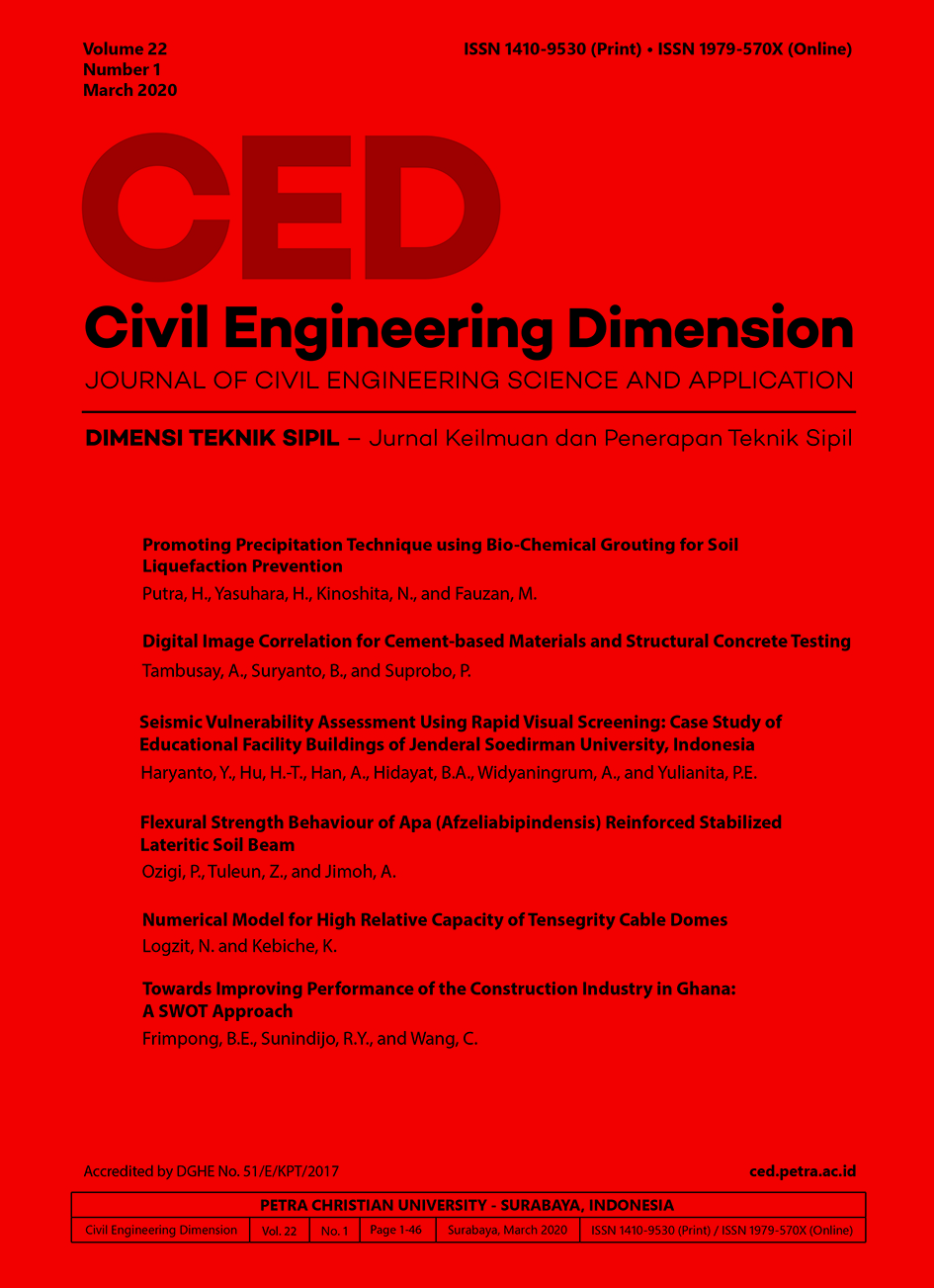Numerical Model for High Relative Capacity of Tensegrity Cable Domes
DOI:
https://doi.org/10.9744/ced.22.1.29-36Keywords:
Cable Domes, Tensegrity, Relative Capacity, Optimization Criteria.Abstract
The tensegrity cable domes are a type of structures composed of compressed bars and tensioned cables. They are characterized by an exceptional innovation in terms of lightness. Research in this area is booming towards multiple applications. In the absence of an approach linking design by dimensioning, this article aims to propose a procedure for verifying the design while seeking a better lightness of the structure. The article uses the novelty of the methods applied for this kind of structure, using the hypothesis of geometric nonlinearity, to find the best solution, verifying all the sizing criteria. Through an example of a simple cables dome, we have shown the feasibility of this approach. The shape of the triangles forming the basis of design, have a direct relationship on the relative capacity, this last has been significantly improved, This method can easily be applied to other examples of more complex cables domes.
References
Tibert, G. (1999). Numerical Analyses of Cable Roof Structures.Licentiate Thesis, Department of Structural Engineering Royal, Institute of Technology, Stockholm, Sweden, TRITA-BKN. Bulletin 46. 1999.
YuanX., Chen L. and Dong S., (2007). Prestress design of cable domes with new forms.Tnternational Journal of Solids and Structures. Vol 44 Issue 9. 2773-2782..
Kawaguchi M., Tatemichi B. Ikuo, and Chen P.S. , (1999). Optimum shapes of a cable dome structure.Engineering Structures, 21(8). 719-725.
Fu F., Lan T.T. , (2002). A study of tensegrity cable domes. Space Structures 5, vol. 1. Thomas Telford, London. 21–30.
Fu F., (2005). Structural behavior and design methods of Tensegrity Domes. Journal of Constructional Steel Research, Vol 61(1). 23 – 35.
Deng H., Jiang Q.F. , and Kwan A.S.K. , (2005). Shape finding of incomplete cable-strut assemblies containing slack and prestressed elements.Computers and Structures, Vol. 83 Issue 21-22. 1767-1779.
Regbielak J.,. (2000). Special forms of structural systems proposed for cable domes. Advances in Architecture Series, Mobile and Rapidly Assembled Structures III, vol. 3. 93–99.
Paulina O., Joanna K. and Wojciech G., (2019), “Truth and Myths about 2D Tensegrity Trusses”, Applied sciences, 9, 179.
Jin Kim, Kanggeun Park, (2018), « The Design Characteristics of Nature-inspired Buildings”, Civil Engineering and Architecture, 6(2): 88-107.
Piotr POLINCEUSZ, (2019), “Structure of architecture – tensegrities in the construction of architectural space”. Architecture Civil Engineering Environment, No. 1/2019, 45-52
Vassart N., R. Laport and R. Motro. (2000).Determintion of mechanisms’s order for kinematically and statically undetermined systems.International Journal of Solids andStructuresVol. 37(28). 3807-3839.
Pellegrino S. and Calladine C.R. (1986). Matrix analysis of statically and kinematicallyInderminat Frameworks.Int. Jour. Of solids and Structures, Vol. 22 N°4. 409 – 428.
Cao Q., and Zhang Z., (2010). A simplified strategy for force finding analysis of suspendomes. Engineering Structures 32 (1). 306-318.
Kebiche K., KaziAoual M.N. and Motro R., (1999). Geometrical nonlinear analysis of tensegrity systems. Engineering Structures, Vol 21, No 9. 864-876.
Ben Kahla N. and Kebiche K. (2000). Nonlinear elastoplastic analysis of tensegrity systems.Engineering Structures, Vol 22 (11). 1552 – 1566.
Bathe K.J., Ramm E. and Wilson E.L.(1975). Finite element formulations for large deformation dynamic analysis.Int. Jour. for Numerical Methods in Engineering, 9. 353-386. .
Murakami H., (2001). Static and dynamic analyses of tensegrity structures, Part 1. Nonlinear equations of motion.International Journal of Solids and Structures, Vol 38 (20). 3599-3613.
Gómez-Jáuregui V., (2004). Tensegrity Structures and their Application to Architecture. School of Architecture, Queen’s University Belfast, September.2004. – 239 p.
Motro R., (2009). Structural morphology of tensegrity systems. Asian Journal of Civil Engineering (Building and Housing), Vol. 10, N° 1. 1-19.
Downloads
Published
How to Cite
Issue
Section
License
Authors who publish with this journal agree to the following terms:- Authors retain the copyright and publishing right, and grant the journal right of first publication with the work simultaneously licensed under a Creative Commons Attribution License that allows others to share the work with an acknowledgement of the work's authorship and initial publication in this journal.
- Authors are able to enter into separate, additional contractual arrangements for the non-exclusive distribution of the journal's published version of the work (e.g., post it to an institutional repository or publish it in a book), with an acknowledgement of its initial publication in this journal.
- Authors are permitted and encouraged to post their work online (e.g., in institutional repositories or on their website) followingthe publication of the article, as it can lead to productive exchanges, as well as earlier and greater citation of published work (See The Effect of Open Access).











